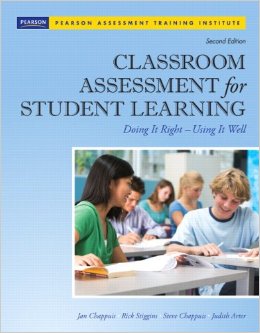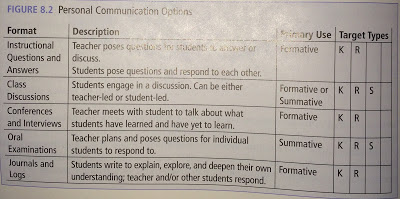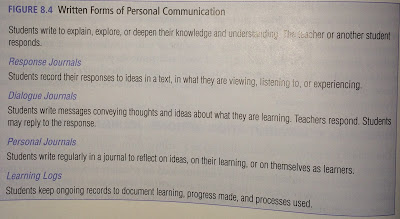Classroom Assessment Chapter 8

 |
| Classroom Assessment for Student Learning Cover. (Accessed 2016). Uploaded to Amazon; Pearson Education. Available online at: https://www.amazon.ca/Classroom-Assessment-Student-Learning-Doing/dp/0132685884 |
 |
| Chappius, et al. (2012). Figure 8.2 Personal Communication Options. Classroom Assessment for Student Learning, pg 266. |
* individual students’ personalities, comfort level, language background, etc can influence the effectiveness of this assessment option
Sampling – Gathering Enough Evidence
– how complex/broad is the learning target?
– is the purpose of the assessment formative or summative?
– there are no rules on how many questions to ask; use your professional judgement
Sampling – Hearing from Students
– it is not often that students will participate equally in a group setting
– call on all students (not just those who raise their hand), use clickers, personal whiteboards, etc
Wait Time
– allow students time to think before demanding answers
– reflection allows for more engagement
Instructional Q’s & A’s
– commonly used during lessons; formative purpose
– be sure to plan questions ahead of time
– be specific if looking for reasoning targets
– encourage more detail, ask for elaboration, build off of other responses
– just keep the conversation flowing!
– Questions for learning
1 ) ask Qs specifically about key points of the target
2 ) students should respond to each other
3 ) model types of responses for students (speculate, reflect, admit you don’t know)
4 ) show how different verbs get different answers
* this is not recommended for summative assessment
Class Discussions
– structured conversations; formative or summative purpose
– be sure to plan questions ahead of time
– develop quality checklists or rubrics (see Ch. 7)
– don’t rely on your memory; make sure you are recording student responses
– Discussions for learning
* use the 7 strategies for formative assessment
Conferences & Interviews
– often used informally while circulating around the room; formative
– don’t need to be used with every students, just those we need more evidence from; use your professional judgement
– be sure to plan questions ahead of time
– avoid “yes & no” questions
– have samples available to clarify
– give students time to prepare
– provide time to review what was shared before concluding the discussion
Oral Exams
– use low level vocabulary
– use 1 set of questions with all students
– develop quality checklists or rubrics
– record and reassess if needed
Journals & Logs
 |
| Chappius, et al. (2012). Figure 8.4 Written Forms of Personal Communication. Classroom Assessment for Student Learning, pg 282. Biases & Problems – not enough time
_____________________________________________
I WANT TO KNOW:
How do you build in personal communication assessment into your classroom?
I often arrange enters or stations for my students to circulate through during a class period where one stop is a conference with me; I find it very beneficial!
Please leave your thoughts below 🙂
|